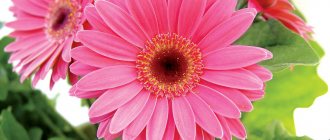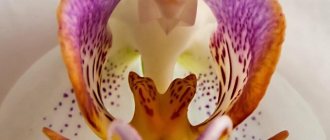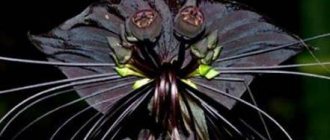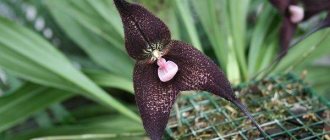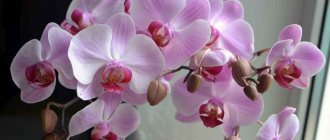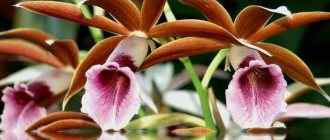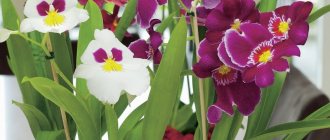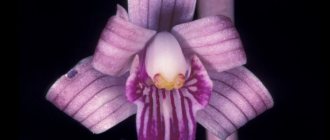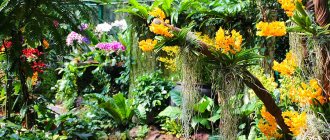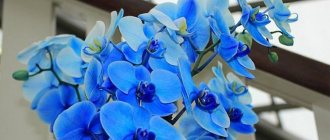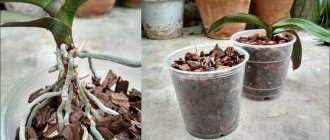Only a few of the 35 or 45 species of the genus Lycasta are suitable for growing indoors, since most are large orchids for which window sills are too cramped a space.
The plant's homeland is a narrow strip of territory running from the southern provinces of Mexico along the mountain slopes of the Andes through Ecuador and Colombia and further to Bolivia and Peru. Some species live far from their main range - in Jamaica, Cuba, the Caribbean islands and the Brazilian state of Mato Grosso. In Guatemala, one of the natural species - the Skinner's lycaste, or maiden orchid - is especially revered and has been elevated to the national symbol of the country under the name White Nun.
The beautiful flower presumably received its generic name from the name of the daughter of King Priam, the ruler of the legendary Troy, mentioned by Homer in one of his works.
Almost everywhere, orchids grow at an altitude of 1 thousand to 2 thousand m above sea level; they are not found lower or higher. The climate of the extreme points of distribution is a humid, warm or temperate season, followed by a cold and dry season, or constantly damp, cool weather with almost imperceptible temperature fluctuations after changing seasons.
Appearance of the plant
Lycastes have a sympodial growth form. Two or three ovoid or pear-shaped pseudobulbs are connected by a rhizome. From their top grow 2–3 folded leaves, elliptical or elongated-oblong in shape. Peduncles, shorter in some species, up to half a meter in others, appear from the base of the pseudobulb, in numbers of 2–5 or more than ten in yellow-flowering varieties, but each bears a single flower with a circumference of 5 to 20 cm, incredibly beautiful and fragrant.
The petals themselves are small, covering the column, but the sepals are much larger, located at an angle of 120 degrees to each other and form a kind of triangle. It seems like a wax flower, its petals and lip are so tight. The palette of shades is different - from white and soft pink to greenish-yellow, orange and brownish. Flowering usually begins in summer and lasts about two months, but winter-flowering species are also found in the genus.
Wanda
A genus of orchids often found among flower growers, which is valued for its easy care and beautiful flowering. It is believed that the American Indians gave this name to the flower.
The plant can reach one meter in height, forms a peduncle with a varying number of flowers (from 3 to 15). At the same time, plants can produce up to 3-4 flower stalks. Belongs to monopodial orchids; it does not form bulbs. Color range: lilac, blue, purple, pink white.
With proper care, flowering lasts up to 2-3 months; the plant blooms several times a year. The genus Vanda includes up to 50 species (combed, great, Suarez and others).
Yellow orchid
It is a hybrid species that was bred by breeders specifically for growing indoors.
The orchid is compact and has dark green leaves. About 10-50 medium-sized flowers are formed on one stem up to 50 cm long. Their color is mainly yellow, although there may be splashes of pink (in the core or on the lip).
The flowers have a pleasant honey aroma. With good and proper care, the orchid blooms for up to six months.
Substrate for growing and planting lycastes
In nature, lycaste grows on the ground or on trees covered with moss; at home, it is grown in pots filled with a breathable substrate consisting of chopped fern roots or the bark of deciduous trees, sphagnum moss, dry leaves and medium fractions of charcoal in a ratio of 2: 1:1:1.
Lycaste is usually replanted annually; both the flower container has to be changed, because the pseudobulbs formed during the period between transplants are cramped in the old pot, and the substrate, since plants react extremely negatively to its salinity.
During transplantation, carefully inspect the roots. Those that are dead or show signs of damage are removed, and the cut-off areas are crushed with crushed charcoal powder to prevent fungal or bacterial infections from penetrating the wound.
Mysterious orchids
Collectors are trying to get rare specimens for their collection, among which one can highlight a green space called “Rothschild’s Slipper.” This is one of the most expensive plants of this species. Its price soars to $5,000.
This rare specimen is difficult to grow, and it blooms only after 15 years. “Rothschild’s slipper” is a flower of incredible beauty, which is why it has such a high price.
The “Mouth of the Dragon” can be called a rarity. It grows in swamps and wetlands in the United States, North America and Canada.
The solar orchid is the rarest specimen in the world of flowers and pleases with its buds only in warm weather. It grows only on the island of Tasmania.
The Hawaiian swamp orchid is blessed with beautiful velvety petals and pale green leaves.
The bull orchid got its name because of its curled petals that resemble the horns of a bull. Its flowers can be white, green and purple.
The Three Birds Orchid is endangered. These rare flowers bloom in forests, clinging to the trunks of deciduous trees.
Precious orchids are mainly grown by collectors around the world. The appearance of their leaves is more attractive than the flowers.
Lycasta care
It is impossible to develop uniform rules of care for all lycastes, since they grow in different climatic conditions in nature, although the numerous hybrids and varieties that have been bred are more acclimatized to home conditions than natural species.
Placement in the house and requirements for temperature and lighting
Lycasta will take root well on the windowsill of a large window facing west or east; on a south window it is too hot in summer, and the plant will need shading from scorching rays. In northern rooms, the orchid develops inactively and often refuses to bloom. In winter, most lycastes enter a resting phase, and they do not need additional lighting, which cannot be said about varietal and hybrid orchids.
The temperature during the period of active development ranges from 22 to 27 degrees Celsius. When the plant begins to prepare for rest and shed its leaves, the temperature in the room is gradually reduced to 15 degrees above zero, and during dormancy the lycaste is placed in a cool, about 12 degrees Celsius, and dry room. For active flowering, most species require a nighttime temperature decrease relative to the daytime thermometer readings by 6–10 degrees. In spring, lycastes are taken out into the garden and placed in places protected from drafts under the diffused light of tree crowns.
Watering, spraying and fertilizing lycastes
The watering regime for lycasta is developed individually depending on the climatic conditions in which the plant grows in nature. Orchids of temperate latitudes develop well in conditions of low air humidity - 35–45% and require not too frequent and abundant watering. It is necessary to focus on the condition of the substrate; naturally, you cannot allow too much drying, but overwatering will have an immediate effect - the first symptoms of rotting of the root system and the base of the pseudobulb will appear.
Important! When watering and spraying, do not allow water to get into the center of the new growth.
The plant responds well to watering by immersion in a container with warm and soft water for 10–15 minutes. After removing the pot with the orchid, you should allow the water to drain well through the drainage holes and only then return the lycaste to its permanent place of keeping.
Flower growers have different opinions regarding spraying. Some argue that lycastes need regular sprays of moisture during the warm season, others argue that in orchids of this genus, after drops of water fall on the leaves, small black spots appear and they advise spraying only the flower, and blot the moisture that gets on the leaves with a dry napkin. In this regard, it is worth noting that the need for spraying depends on many factors - living in nature, indoor microclimate - temperature, lighting, as well as air ventilation and others.
During the active growing season, lycastes are fed with special fertilizers for orchids, diluted in half or a quarter dose relative to that indicated on the package. The frequency of fertilizing is through watering.
Orchid color in clothes
The shades of Radiant Orchid are on the verge of pink and purple. The highlights of these tones on the skin give it a healthy shine. The color itself is universal: it can be worn by both women and men. The attractive Orchid immediately conquered the catwalks during the spring-summer fashion shows 2014, and from there this color easily migrated to the red carpet for film and pop stars.
Such fashion pillars as Emerson by Jackie Fraser-Swan, Juicy Couture and Yoana Baraschi began to introduce shades of Radiant Orchid into their spring 2014 collections. Various versions of this fashionable shade of 2014 are included in both women's and men's collections of clothing and accessories.
Leaf fall and dormant period
Caring for lycaste in winter differs from maintenance during active growth. In many sources there is a statement that a characteristic feature of plants of the genus is the loss of leaves every dry season, i.e. during dormancy. However, this does not apply to all species; in some, the leaves do not fall for 2–3 years and only then die.
With the beginning of the resting phase, they stop feeding the lycaste and practically do not water it, but they monitor the condition of the pseudobulbs, trying to prevent them from shrinking. If such symptoms appear, the pseudobulbs are moistened with a spray bottle, but not abundantly - during this period, under conditions of cool dormancy, the plant is very vulnerable to various types of infections.
Hybrid lycasts do not always go into a dormant phase, but continue to develop, forming new growths and peduncles. In winter, they require additional lighting, a room temperature of no higher than 24 degrees Celsius and moderate watering.
Description and area of growth
The Orchid family is one of the largest on Earth. These plants populate almost our entire planet : they are subject to the climate of the tropics and even the subantarctic. Orchids can grow on wood, moss, soil, mountains, etc.
The only place where they are not yet available is the cold shores of Antarctica. Basically, most varieties are found in Australia, Asia and America. This is due to tropical and subtropical latitudes, which create optimal conditions for the growth and reproduction of orchids.
One of the largest, perhaps, can be called epiphytic orchids. These are plants that grow on the bark of trees and can exist at fairly high altitudes. They are not parasites , but use the tree trunk to reach the sun's rays higher up.
Note! Most varieties of such orchids live for more than 50 years; they feed from the air (tropical rains, sun rays, etc.).
Among the most popular varieties are Vanda, Vanilla, Phalaenopsis, Cattleya, etc. Let's look at them in a little more detail.
Reproduction of lycastes
Seed and meristem methods of propagation are not used at home, only in greenhouses and greenhouses. For lycastes grown on a windowsill, dividing the rhizome during transplantation is most appropriate.
An adult bush with several pseudobulbs, after immersion in water, is carefully removed from the flower container and the root system is freed from the old substrate, carefully handling the fragile roots. The rhizome is dissected with a disinfected sharp knife so that 2–3 pseudobulbs and young growth remain on each section. The incision sites are crushed with crushed charcoal to protect against fungal infections. The delenki are planted in a new substrate and cared for in the same way as adult lycastes.
How to determine the type of orchid by flowers
There are a great many species, varieties and hybrids of orchids, and it is not so easy to remember the names, as well as the characteristics of certain varieties.
Based on the type of growth, there are two large groups:
- monopodial;
- sympodial.
The first group includes plants that have one (hence the name “mono”) stem, directly on which leaves form. Buds of orchid flowers form in their axils. The stem is straight and grows upward, while plants of that group lack pseudobulbs.
The most common types of monopodial orchids are phalaenopsis and vanda. The latter can grow well and delight with flowering even without a substrate.
Sympodial species form several shoots that grow from the very base. Flowers are regularly renewed; as soon as one bud fades, new buds are formed in its place. Such orchids have pseudobulbs, which can be used as propagation material. This group includes beautiful cattleyas, magnificent cymbidiums, unpretentious dendrobiums, as well as laelia and oncidium.
The group of orchids that have luxurious leaves (varieties Goodyer, Makodes and others) is called Precious.
Diseases and pests
Some problems with the condition of the flower are directly related to errors in care. From a lack or excess of lighting, yellowing of the leaves is often observed, and the appearance of black spots on them is associated with spraying and drops of water falling on the leaf plate. Sometimes a slowdown in growth becomes apparent, accompanied by a lack of flowering. There are several reasons for this phenomenon - salinization of the substrate due to untimely replanting and watering with hard water, lack of nutrients, non-compliance with the rest period.
Among the diseases, the most common are various rots caused by fungal or bacterial infections in conditions of excessive moisture.
The most common pests on lycastes are mealybugs and scale insects, and in conditions of low humidity, spider mites also appear. If few insects are found, they are washed off with a 20% soap solution. In case of numerous lesions, plants are treated with insecticides.
Orchid color in cosmetics
A modern and amazingly versatile shade, Radiant Orchid gives your skin a more vibrant tone and makes you feel healthy and attractive. Orchid shades are on the border between cold and warm tones; they do not spoil warm skin color and highlight cold color types. In addition, many brown and black shades of hair in combination with Orchid will become brighter and more attractive. It is worth noting that it is an advantageous combination with different eye shades. This is primarily tea and all shades of brown, gray, gray-blue, swamp green and blue-green chameleon eyes. The multifaceted color of Orchid is seductive in combination with crimson shades, as well as various shades of lavender, lilac, lilac tones, which provides a rich palette of lipsticks, eye shadows and blushes. The abundance of the Radiant Orchid is also evident in the wide range of nail polishes and “glitter touches” to them.
Types of lycastes
Virgin, or Skinner's (virginalis) is one of the most beautiful plants in the genus. A pair of ovoid leaves is formed from the pseudobulbs. The peduncles grow up to 25–35 cm, and white-pink fragrant flowers about 15 cm in circumference form on their crown. The lip is three-lobed with a slight yellowness or pure white or with barely noticeable crimson to purple streaks and small polka dots. It blooms throughout the month from late autumn to early winter, but the peak of active bud formation occurs from January to mid-spring. Thanks to its long peduncles, the orchid is used for cutting. Hybrids of Japanese selection are especially popular among flower growers, for example, lycasta sakura with short leaves and a large pink flower with a diameter of up to 9 cm, in the creation of which the breeding material of this species was used for 80% and 6–7% each from the types of lycasta large-leaved, blood-red and krinites.
Virgin, or Skinner's (virginalis)
Short-winged (brevispatha) is a compact plant with peduncles shorter than the leaves. The sepals are greenish in color, sometimes with pink dots and tips bent back. The petals are snow-white with a slight pale pink tint. The lip has a weakly defined three-lobed outline, white, occasionally with barely visible light pink specks.
Short-winged (brevispatha)
Aromatica (aromatica) is one of the most popular lycastes in indoor floriculture with yellow-orange flowers that exude a subtle spicy aroma. Two varieties are known: one with small flowers with a circumference of no more than 4–6 cm, narrow sepals and anterior lip blade, the second with larger flowers with a diameter of up to 8 cm, with wide perianth lobes.
Aromatica
Cochleata - with small yellow flowers about 4 cm in circumference and a characteristic expressive swelling at the base of the lip, steeply curved downwards. Blooming flowers smell like chocolate.
Cochleata
Blood red (cruenta) is a small orchid with short flower stalks, cinnamon-scented flowers at the top located below bright green oval leaves. It is not clear on what basis the name was given to the species, because the flowers of the plant are orange-yellow, and the red spot at the very base of the lip is visible only if you look closely. The sepals are yellow-emerald in color and are effectively bent back. Flowering in this species lasts for one and a half months, and leaf fall occurs once every 2–3 years.
Blood red (cruenta)
Macrophylla is a large plant up to 70 cm high with thick ovoid pseudobulbs almost 10 cm high and 3–6 cm in diameter in cross section, often flattened on the sides and several longitudinal grooves. From the tops of the pseudobulbs, 2–3 fan-shaped leaves are formed, 45 to 75 cm long, which fall off at the beginning of winter. The peduncles are short, no more than 18–20 cm, with one flower at the top, large and fragrant. The color of the sepals varies from olive greenish and light brown to dark chocolate. The petals and lip are white, often with small pinkish, scarlet or purple small polka dots. Peak flowering is in May, but often forms flower stalks at other times of the year.
Macrophylla
Indoor
With all the variety of species of these wonderful plants, not all of them can be grown indoors. Therefore, if you are excited about the idea of breeding orchids, you need to know about the most suitable species for your home.
Brassia
Orchid “Spider” - this is how people affectionately call that flower. And all because its graceful flowers are very reminiscent of spiders.
This genus includes more than 50 different species.
Brassia flowers have thin narrowed sepals and shortened petals. Colors: brown, lemon, white, lilac. Almost all species of Brassia have speckles scattered on their flowers. Flowering is long lasting and is accompanied by a very bright and strong aroma (the smell is similar to the aroma of daffodils).
Cumbria
Three species of orchids (Miltonia, Brassia and Oncidium) “participated” in the creation of this magnificent hybrid. Cambria is often called "star" because its flowers look like miniature purple stars.
The color of the petals and sepals varies: from pink to crimson and purple. The size of the flowers is from 1 to 10 cm. The plant is characterized by narrow leaves, the presence of a large number of pseudobulbs, and long peduncles. Among gardeners it is considered the most unpretentious type of orchid. The hybrid was developed specifically for those who would like to grow an orchid at home.
Cattleya
This type of orchid is distinguished by its exquisite flowering and delicate aroma. The group includes more than thirty varieties, and a large number of hybrids have also been bred. The plant has long leathery leaves (up to 30 cm), original flowers of various shades: white, greenish, purple, crimson, lilac with various contrasting inclusions.
You may be interested in: How to care for orchids in a pot after purchase Why the leaves of an orchid wither and how to save it Features of the care and propagation of the Dendrobium Nobile orchid
Flowering is long-lasting (up to 9 months). The flowers have a very delicate aroma, similar to lily of the valley.
Dendrobium
An orchid from the epiphytic group, the genus includes a huge number of species. Moreover, they all differ in size, shape and color of the petals, as well as growing conditions.
In nature, dendrobium grows on trees, hidden in their dense crown.
The leaves are oval, the shoots are medium sized, and have the appearance of a cylinder. During the flowering period, this entire cylinder is covered with flowers. Shades: white, dark purple, pink, orange, purple, with spots and dots. The number of flowers depends on the variety, ranging from 30 to 100 pieces on one peduncle. Almost all varieties of dendrobiums have a pleasant fragrant aroma.
Lycasta
This genus of orchids is the symbol of the state of Guatemala (Lycastus skinner's orchid). The genus includes more than four dozen orchid species, all of which have a pleasant, subtle, enchanting aroma.
Lycasta is an orchid that is suitable for growing indoors. Peduncles are formed in bulbs, each with one or two large flowers. Petals and sepals can have different colors: yellow (primary color), orange, white, pink, greenish-yellow, pink. The main color scheme contains contrasting spots, dots, and inclusions.
Lycaste orchid is an excellent cut flower.
Miltonia
The orchid is an epiphyte, which is often called “pansy”. The genus Miltonia includes about twenty different species of orchids. Valued for its unpretentiousness and beautiful flowers.
It has large leaves and large flowers. Shades depend on the type, among the predominant ones: white-yellow, purple, pink, milky white, lilac. Many varieties of miltonia have petals with spots, stripes, dots, and a border (pink on a white background, brown on a yellow background).
The aroma is pleasant. Miltonia has a long flowering period.
Odontoglossum
This genus of orchids is distinguished by very abundant flowering. Odontoglossum is a rare indoor plant; breeders have developed numerous hybrids based on it.
It has flat flattened bulbs, thin leathery leaves of a linear shape. Paniculate inflorescences are formed on long drooping peduncles; each can contain up to 15 flowers. The diameter of the flowers is up to 5-7 cm. The petals and sepals are narrow, have shades: burgundy, pink, yellow, brown, greenish. There are always spots and stripes (burgundy, brown). Orchid has a pleasant aroma.
Oncidium
One of the most common genera of indoor orchids. Unpretentious, with regular flowering (if appropriate conditions are created).
The flowers are mostly yellow in color, although there are varieties with brown-red, pink and white petals (twinkle, tiger oncidium). The complex name translated from Greek means “tongue” and “tooth,” which indicates the presence of special processes in this type of flower.
Cymbidium
One of the most beautiful orchids that are grown in apartments and also in greenhouses. The flowering plant has a very pleasant, delicate scent; it is not for nothing that the Chinese call cymbidium the “queen of aromas.”
It has long leaves, drooping peduncles, and luxurious large flowers. The color palette is very diverse: yellow, pink, white, purple, brown, green shades.
The largest types of cymbidium are grown in greenhouses for cutting. It is quite fastidious in care and requires the creation of certain conditions (temperature, watering, lighting).
One of the most luxurious and colorful is the black cymbidium - an orchid with dark purple, almost black flowers.
Orchid blue
One of the rare hybrids obtained as a result of breeding work by scientists in Japan. Not available for free sale.
The plant is characterized by small leaves, long peduncles, on which up to 25-30 buds of soft blue color can bloom.
ON A NOTE!
This hybrid should not be confused with orchids tinted blue and which are essentially fakes (for example, blue phalaenopsis). Such plants do not exist in nature.
An exclusive orchid that can only be in some collections of true orchid lovers.
Orchid color in the interior
Novelty in the interior is a movement forward. And if innovation is the trendy color of the year, then it is not only a surge of energy, but also the best way to adapt to the modern world. Radiant Orchid creates fresh, contrasting and very attractive combinations with olives and deep forest shades of green, and combines perfectly with turquoise, emerald and even light yellow tones. In addition, Orchid shades will enliven neutral colors such as beige, gray, dark gray. The energetic and bold colors of 2014 can bring together many of the colors and design elements of your home space without being oppressive.
This is how the color Radiant Orchid was presented by the PANTONE Institute as the color of 2014.
